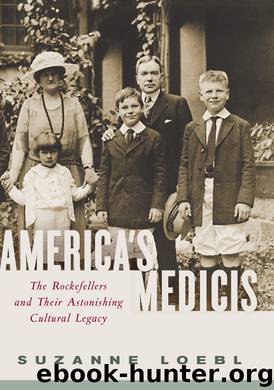America's Medicis by Suzanne Loebl

Author:Suzanne Loebl
Language: eng
Format: epub
Publisher: HarperCollins
Chapter 10
A Modest Man Assumes His Birthright: The Asia Society and Lincoln Center
THE ASIA SOCIETY
IN 2006, to celebrate its fiftieth birthday, the Asia Society mounted an exhibition entitled A Passion for Asia: The Rockefeller Family Collects.1 The shows—actually there were two consecutive ones—occupied two floors of the New York headquarters of the Society at Park Avenue and Sixty-ninth Street in Manhattan. Various institutions and members of the Rockefeller clan loaned the objects on display, and the exhibition combined great art with more mundane objects. Old photographs of interiors at 10 West Fifty-fourth Street, the Eyrie, 740 Park Avenue, and Kykuit reminded visitors that the objects on display had been bought for private use. Visitors familiar with Rockefeller lore were informed of who had collected what, and what had been willed to whom. Objects had been subdivided into four separate sections: “Nourishing the Spirit” included photographs of Abby’s Buddha rooms and of related sculptures. “Home as Aesthetic Retreat” emphasized decorative arts and prints. “Landscape Design” illustrated the great Rockefeller gardens at Kykuit and Seal Harbor. “The Archival Room” documented Junior and Abby’s only trip to Asia and the history of the Asia Society.2
A large gilded Buddha from the Ming period (1368–1644) greeted visitors upon their arrival. This seated Amitabha Buddha, also known as Buddha of the Western Paradise, usually lives in the Abby Aldrich Rockefeller Garden in Maine, where it is paired with an almost identical Shakyamuni Buddha. The most famous of the Rockefellers’ Asian statues, the seventh-century Tang-period bodhisattva, which at one time greeted visitors in the entrance of their brownstone on Fifty-fourth Street, shared a gallery with other large statues.
The Museum of the Rhode Island School of Design sent a selection of Abby’s Utamaro and Hiroshige prints, and robes from the Lucy Truman Aldrich Textile Collection. Abby’s grandson Steven C. Rockefeller contributed a contemporary Japanese woodcut by Itō Shinsui of a traditionally clad young woman shown against a full moon. Steven, professor emeritus of history and religion at Middlebury College in Vermont, also lent a small ivory statuette of Guanyin with Child, from China’s fifteenth-century Ming period, which closely resembles a medieval European work, and a wooden cross, created by George Nakashima, the American modernist furniture maker. The simplicity and beauty of the finished artwork attests to the artist’s reverence for the life of the tree, and of his responsibility to justify its sacrifice.3 The Met loaned some of Junior’s Chinese porcelains and Kashyapa, a wooden polychrome figure from 1700 Korea, a gift from Abby Rockefeller. John D. (Jay) Rockefeller IV and Hope Aldrich, two of John 3rd and Blanchette’s children, sent an elaborate gilt-bronze Eleven-headed Lokeshvara encrusted with jewels, and a simple Buddha from Thailand.
The David Rockefellers had a particular liking for animal art and contributed a unicorn and a deer, from Nepal, dating from the thirteenth to fourteenth century CE, and an eighteenth-century Tureen and Cover in the Shape of a Goose they had inherited from their aunt Lucy. The most beautiful objects of the show, however, were favorites selected from the 285 pieces Mr.
Download
This site does not store any files on its server. We only index and link to content provided by other sites. Please contact the content providers to delete copyright contents if any and email us, we'll remove relevant links or contents immediately.
The Social Psychology of Inequality by Unknown(2937)
Make Comics Like the Pros by Greg Pak(2852)
Stacked Decks by The Rotenberg Collection(2810)
Purple Hibiscus by Chimamanda Ngozi Adichie(2648)
The Queen of Nothing by Holly Black(2491)
The Art of Doom by Bethesda(2106)
Life of Elizabeth I by Alison Weir(2026)
Putin's Labyrinth(1959)
The Power of Habit: Why We Do What We Do in Life and Business by Charles Duhigg(1937)
Drawing Down the Moon by Margot Adler(1824)
Things Are What You Make of Them: Life Advice for Creatives by Adam J. Kurtz(1816)
Wall and Piece by Banksy(1778)
Agency by William Gibson(1777)
Art Of Atari by Tim Lapetino(1743)
Teaching to Transgress: Education as the Practice of Freedom (Harvest in Translation) by Bell Hooks(1693)
The Beatles Lyrics by Hunter Davies(1670)
The Pin-Up Art of Bill Ward by Bill Ward(1650)
Only What's Necessary: Charles M. Schulz and the Art of Peanuts by Chip Kidd(1644)
The Andy Warhol Diaries by Andy Warhol(1560)
